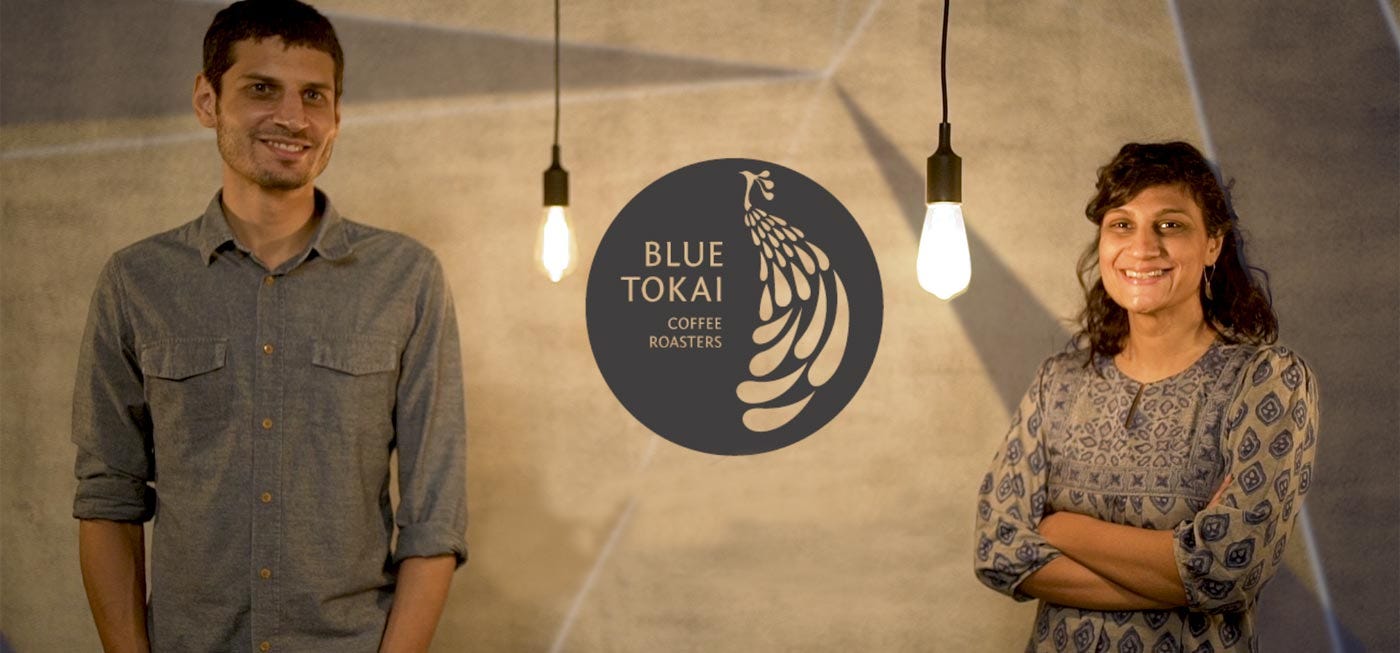Blue Tokai: From A Humble Estate to Global Expansion
Brand breakdown 02: Brand Breakdown is Shopflo’s monthly 4-part newsletter, in which we deep dive into an Indian D2C brand, and understand its constituent elements to figure out what makes it tick ⏰
It's good news for all coffee lovers because Blue Tokai is this month’s pick. In today’s newsletter, we discuss the beginnings of the brand, the challenges faced by the founders, and how they grew the brand in a market that is getting increasingly crowded.
The coffee industry in India is undergoing a massive change, and in small ways, it could be owed to Blue Tokai. Started by a couple who had no background in coffee- Matt Chitharanjan and Namrata Asthana, the brand is a result of their quest to find good coffee.
A finance graduate and an economics graduate met in Chennai
Matt Chitharanjan whose parents were from Chennai, grew up in the US, with degrees in finance and economics. His work with Institute for Financial Management and Research brought him to Chennai, where he met his wife Namrata Asthana who was working in the same organization. A psychology major, she had previously worked in the communication departments at Pepsico and the American India Foundation.
When work took the couple to Delhi, they missed the fresh filter coffee they had gotten used to in Chennai. The instant coffees that lined all the supermarket shelves just didn’t cut it. After initially toying around with the idea of starting a microbrewery and eventually discarding it due to the difficulty in licensing and logistics, they finally landed on coffee.
Scoffed upon by the older generation of farmers, the couple didn’t deter
At the time, ‘good quality’ coffee meant either extremely high-priced imported coffee, like Davidoff, or lattes and cappuccinos at the booming cafe chains that were serving average-quality coffee. India was also known for its low-cost, low-quality coffee, while in fact, there were a lot of estates within the country producing high-quality beans that were being exported all throughout the world. And that was their starting point.
They began by attempting to set up meetings with numerous coffee estates. After a long period of tortuous silence that usually accompanies the practice of cold calling, the farms started getting in touch with them one after the other. Although they were initially scoffed upon by older generations of farmers who didn’t think India was a market for specialty coffee, they eventually managed to convey their vision and win them over.
9 years steady and one thing has remained constant
They began by investing in a roaster and roasting the beans they sourced from these farms; thus, the brand Blue Tokai was born in 2013. Sales started coming in online, and their lives were an endless cycle of roasting, hand-cutting labels, and delivering the perfect package of coffee. To this day, they roast in small batches that are made to order as flavor compounds break down as time from the day of roast increases, and the coffee won’t taste as fresh.
Their first investment came in 2016 in the form of seed funding from Snow Leopard Ventures and Bold Ventures. Over 8 rounds, they’ve now raised $15.6 million with the latest funding coming from Mauryan Capital and Negen Capital Services on March 8, 2022. In 2020, they had a turnover of 42 crores, with a CAGR of 85% in the previous 6 years. With the coffee industry touted to reach over $4.3 billion in 2025, Blue Tokai aims to keep pace and constantly innovate.
The offline coffee experience is what elevated their brand
Out-of-home consumption of coffee is expected to account for 20% of the market in 2025. This outlines the growing importance of the experiential aspect of coffee. Around the time Blue Tokai launched online, Starbucks was heavily expanding their outlets in India. The cafe experience at Starbucks played a huge role in defining the lifestyles of young, mobile, metro-dwellers.
Blue Tokai’s first cafe opened in Delhi. It began with the vision of an espresso bar where customers could taste their coffee before buying roasted beans. Once they started serving flat whites and pour-overs, the demand for food options and wifi service increased. Revoking the franchise model, they decided to expand while owning and operating all their stores to maintain quality.
From home brews to Japanese cafes
Currently spread over 51 cafes in 10 cities, the innovation in the menu is apparent in the coffee and tonics and kombuchas. Consumer education is a top priority when it comes to Blue Tokai, and some of their cafes host brewing, roasting, and cupping sessions. Raising the bar in terms of different formats of coffee, Blue Tokai also started flavored coffee cans, coffee pods, capsules, and cold brew bags to make the process of coffee consumption more convenient.
Blue Tokai has also entered the Japanese market in a joint venture with Nichiin Food Creative Corporation. With a B2B model, Blue Tokai carved a space in numerous cafes and online stores in Japan, where the feedback for their products was strongly positive. This intercultural food collaboration also opens up the possibility of cross-border alliances in the food industry.
For a couple that did not come from an F&B background, the drive to provide good quality coffee is what took Matt and Namrata from roasting beans at their home, to the cafes of Japan. By differentiating on the basis of both the length and breadth of the product range, they’ve managed to lead the way in terms of innovation in the specialty coffee space.
Happy Brewing!
In the next edition of this month’s brand breakdown, we’ll be catering to the creative minds’ by discussing Blue Tokai’s branding: the packaging, colors, and visuals that have helped build a unique identity for the brand.
Write back to us for any suggestions, feedback, or collaborations! Happy to connect
In case you missed the previous edition, here you go




